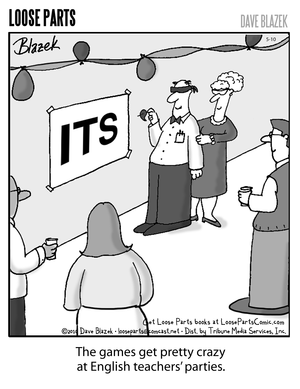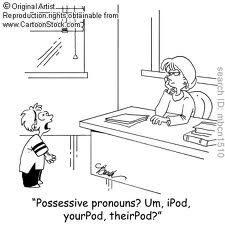Case part four
Last time I wrote that objective case is for direct objects and other things. Today we’ll look at one of those other things. Think of the objective case as appropriate for anything that’s not a subject and not possessive.
That means you use the objective case with prepositions, and that’s where many people mess up. And it’s your teacher’s fault! Remember you used to say, “Me and Tom are gonna go play in the park.” Your teacher would pounce on you, saying, “Tom and I are going to the park.” And you would endanger your life by saying “Oh! Do you wanna come to?”
We humans are pattern recognizers, and that pattern of putting someone or something else ahead of “I” became imprinted in our minds, so we used it all the time, even after prepositions. This produced sentences like ” The company finances were worked out between the company president and I.”
Sorry—”between” is a preposition. So are a large number of other words. Google “preposition” if you have any doubt what they are. (By the way, “like” is a preposition. The book title Black Like Me is correct.) After a preposition use me, us, him, her, or them. English doesn’t have a separate form for “you” except in the joke, when you act all high-falooting and say, “Whom are youm?” (To which you would get the reply, “I am me-em.”)
We don’t get it wrong when the pronoun is alone, so a good way to check if you have a sentence correct is to leave out the other person. Suppose your English teacher scolded you and Tom for getting your pronouns wrong. You would not say “He really gave it to I,” you’d say “He gave it to me.” So you know the sentence should be “He gave it to Tom and me.”
I mentioned in the first post about case that the only reason to mention the other guy first is that it’s more polite. If you name yourself first, though, you will use the correct case. It’s easy to say, “He really gave it to me and Tom for not being humble.” That isn’t humble, though, so don’t do it.
That’s it for grammatical case for a while. Fill out the form on the right for some more pointers on how to write well.
Subscribe to this blog's RSS feed
Case part three
Nominative case—subject of a sentence and predicate nominatives
Objective case—Direct object and other things
That leaves possessive. Not very many people have trouble with this one, except for possessive pronouns and plurals. We’ll get to those in a moment.
Did you ever wonder where the apostrophe came from? English is a Germanic language, and the possessive form in German ends in -es. You can see this form in Old English. As time passed, we dropped the e and replaced it with an apostrophe, same as with contractions. So our possessive nouns are really contractions.
Here’s the rule for making correct possessive nouns:
- Look at the word you want to make possessive, plural or not.
- Does it end in “s”? Then add an apostrophe and you’re done. For example, my first name is Rogers. This blog is mine, so you could say that The Writing Rag is Rogers’ blog. If you pronounce it “Rogerses,” you are correct.
- No “s” at the end? Then add apostrophe-s and you’re done. My evil twin is Roger. He does not own this blog, so this is not Roger’s blog. You would pronounce this “Rogers.”
Why couldn’t you add apostrophe-s to Rogers? You could, but then you have a problem with words like waitress. Three of the same letter in a row is forbidden in English. (Can you think of the exception to this rule?)
On to the pronouns. Here’s the rule: Memorize them! His hers its. Not an apostrophe in sight. They are their own form. They are not nouns—don’t do the apostrophe! Harrumpf!
Hundredth Post
We interrupt the scintillating discussion of grammatical case to celebrate writing on the hundredth post of this humble site. This post contains a sample of some marvelous writing.
Brooke McEldowney studied viola at the Julliard. He is also a cartoonist par excellence. He writes two strips, 9 Chickweed Lane, about a ballerina and her family and others, and Pibgorn, about a fairy and some other natural and non-natural people. Those descriptions do not begin to do justice to the long, complex, original, erudite, and enjoyable plot lines you will find in each comic, nor the interesting personalities he has created. I recommend you read them. Both are available on GoComics.
I’m not showing a picture in this post because I want you to go read the comic. The sample of writing below is part of what appears below the panel several days into a recently-begun story in Pibgorn titled Mozart and the Demon Lover. (The link goes to the first panel in the story.)
… Glancing one recent day at an online reference site that purports to be encyclopedic, I looked at this very cartoon on its Pibgorn entry. Originally, when the cartoon appeared on that page, the attached caption stated that it was a moment at the beginning of a Pibgorn story, showing the three principal characters. However, my recent fly-by screeched to a halt because the caption had changed. It now stated that they were discussing “the sexualization of music” (whatever that means).
I wrote to someone at the site in order to inform them that the caption was balderdash. A response arrived in due course, dispensing the effluvia that I cannot be a reliable source of information about my own writing because I am too close to it, have too much of a vested interest in it.
I informed the writer that the entire thrust of the first three panels derived from a New York Times music review in the 1980s by Harold Schonberg, in which he asserted that simply performing Mozart was not an adequate practice; that performers had to “sell” Mozart. When I wrote the dialogue to this cartoon, I was reflecting on Mr. Schonberg’s review. At no point during the composition of the panel, or since, have I ever entertained the mystifying codswallop that one can sexualize music (without the assistance of Gypsy Rose Lee, I mean).
The idea that the creator/writer/limner cannot be a reliable source of information on his own work because he is too close to it – that only tertiary sources of canards and crackpottery can be regarded as reliable – proceeds from an arrogance that beggars description. It could kindly be dismissed as moonshine, except that, whence it issues, the moon don’t shine.
Marvelous! Wonderful vocabulary. (Look up the words you don’t know.) Perfect grammar. Syntax at once clean and complex. This is the highest of high dudgeon. I love it.
Case part two
We use the subjective (nominative) case for two things in English—the subject of a sentence or clause, which everyone gets pretty much correct pretty much all the time. The other place for the nominative is in a construction called the predicate nominative. Remember that term? I’ll explain it later. First we need two items of background.
First, think about how basic sentences are constructed in English. One basic sentence goes Subject, Verb, Direct Object. In that order. Since English has dropped a lot of inflectional endings, the order is usually important. Tom saw Mike is different from Mike saw Tom. (Notice that both names have the same form in both places) A lot of languages put a syllable or so at the end of a word to indicate how it’s used in the sentence. In Greek, for example, we might have something equivalent to Tomos saw Mikeon and Mikeos saw Tomon. That -os and -on are inflectional endings. It’s handy, in a way, to have inflectional endings because if you write Mikeon Tomos saw, your reader would know who saw whom without needing the word order. In fact the Greeks played with word order a lot because they could, with all those inflectional endings, and they had a lot of them.
Direct objects aren’t in the nominative case; they ‘re in the objective case, even if English doesn’t use an inflection to say so. Hence the ‘whom’ in the previous paragraph. That -m on whom is an inflectional ending. Literally, if I had written “who saw who.” I could have been writing about someone looking at his reflection in the mirror. (You might object that the reader can figure it out from the context. True, but that violates one of the main tenets of good writng. I mention it in that freebie order form in the right margin of this blog, but if you ask me directly, I’ll just tell you.)
When you think about word order, a predicate adjective looks a lot like a direct object.
Now the second bit of background, the verb “to be.” This word, in every language I have any acquaintance with, breaks a lot of rules that apply to most verbs. For one thing, it’s always irregular. You have to learn the different forms; it doesn’t follow the patterns most other verbs follow. We say, for example, “I see, you see, he sees” but “I am, you are, he is.” No pattern. Another thing about “to be” is that it is equivalent to an equals sign, but almost every other verb is equivalent to doing something. When Tom sees, he is doing something. But when Tom is the boss, that means Tom=boss.
Since both ends of a sentence containing some form of “to be” are equivalent, we use the nominative. We would say Tomos is the bossos. The correct case is easier to remember in highly inflected languages. In English, where word order is so important, we get used to the pattern of having the objective case at the end of the sentence, so we tend use it all the time. “It’s me, Oh Lord, standin’ in the need of prayer” goes the song.
My Freshman English professor told this story:
St. Peter, at the pearly gates: Who’s there?
Person: “It is I.”
St. Peter: Ah, an English teacher!
So there you have it. Verbs of being take the nominative. Officially. I suppose it’s a losing battle, but at least now you know.
And I humbly beg the indulgence and forgiveness of you Greek scholars out there.
What is case?
Grammatical case is a subject worth several posts. Perhaps the subject is best approached with a comic first.
I met the artist for this comic, John Wigger, recently on line, in a hang out on Google+. I had been thinking about doing a series on case, and this strip makes a good place to start. Here’s a link to the comic site, Zombie roomie.
Case is a way of telling you how a word is used in a sentence, usually by changing the letters at the end of the word. Every Indo-European language (far as I know) uses case, but many languages don’t. For example, Hebrew (Semitic language family) doesn’t have case.
My sixth-grade teacher taught us that English had three cases—Subjective, Objective, and Possessive. The guy in the comic is using nominative instead of subjective. (Frankly, I like this better. Nominative is the term used in other languages.) Since I’m giving you vocabulary here, I’ll tell you a few more: Objective is called accusative in other languages, and possessive is called genitive. Other cases exist, but not in English.
In future posts I’ll tell you how to get case correct, and warn you against common ways to get it wrong.
One last item. Why did your parents and teachers always correct you when you said “me and Tom” with “Tom and I”? The only reason to put yourself last is humility. It has nothing to do with grammar.



